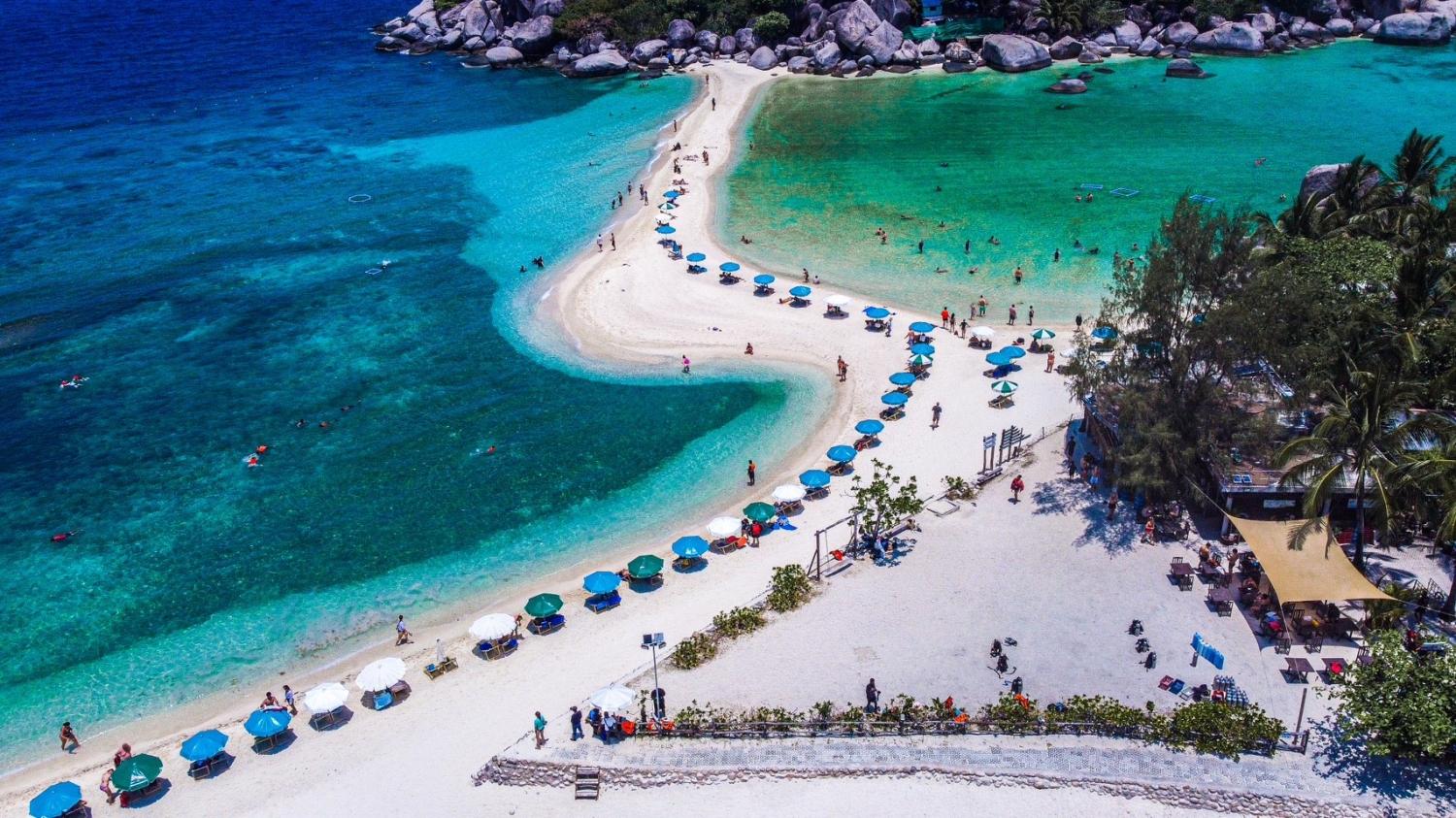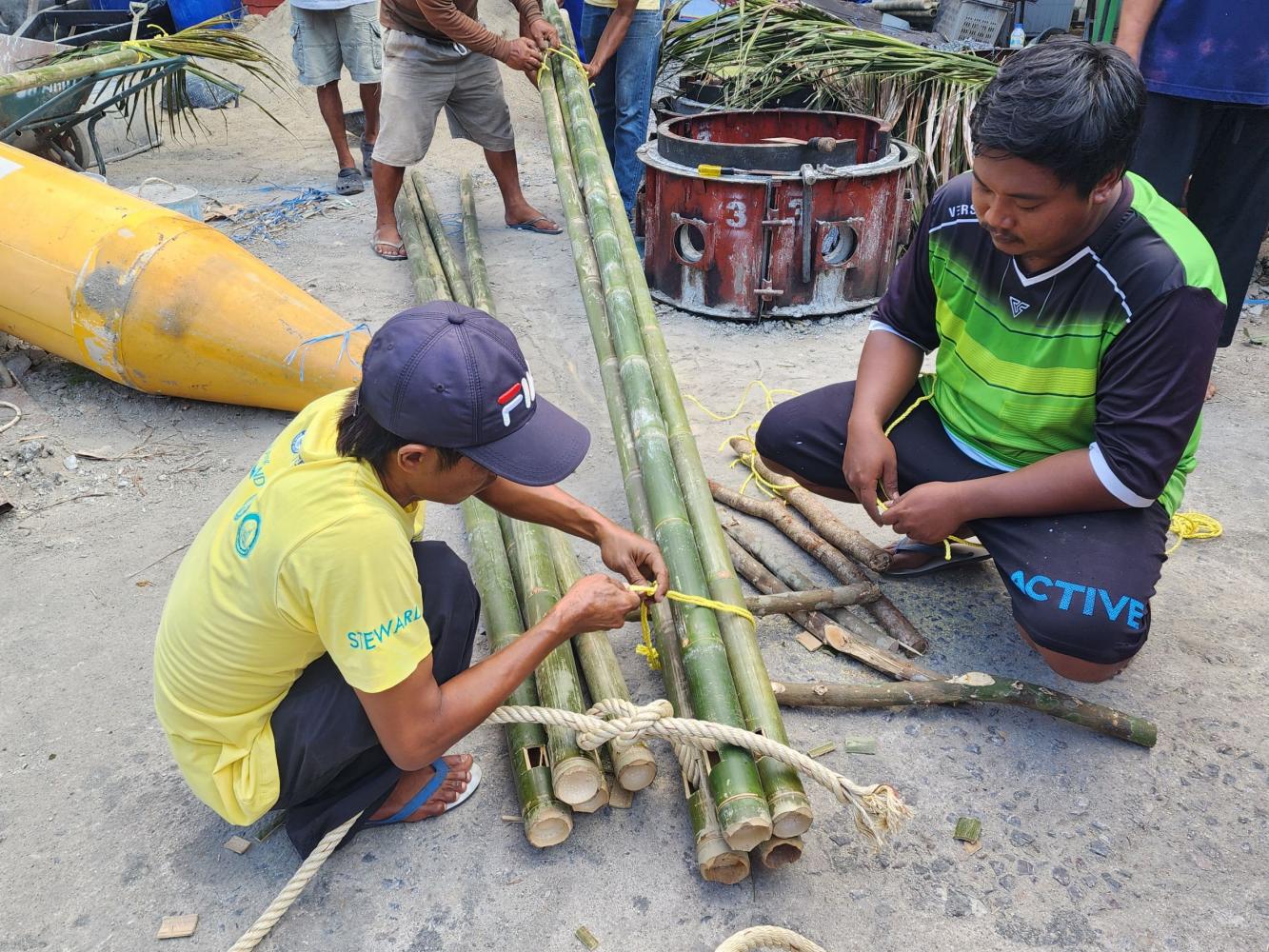After a two-hour ferry ride from Koh Samui, we landed on Koh Tao, where a tremendous influx of foreign and Thai tourists was arriving at Mae Haad Pier in the late afternoon. A crew of hotel guides were shouting their customers' names from a nearby pavilion, while a fleet of four-wheel-drive pickup trucks were stationed outside to transport visitors to their lodgings.
The rain clouds had dissipated and the sky was bright, sunlight mirrored on the turquoise ocean. The temperature steadily rose during this summer day. All entertainment venues and businesses have reopened their doors on Koh Tao and are receiving an estimated 40,000 visitors each month, showing that tourism on the island has recovered since the country's borders were fully opened late last year.
Koh Tao (Turtle Island) has been recognised for its marine biodiversity and serves as a significant breeding site for hawksbill and green turtles on the western coast of the Gulf of Thailand, making it a paradise for scuba divers and snorkellers. In the past, the island was a penitentiary for political prisoners and, conversely, a haven for fishermen from adjacent areas seeking refuge during a storm or to unwind before resuming their journey.
Thanks to the continued popularity of diving, Koh Tao now has 64 diving schools, as well as many tourist-related facilities to serve those on diving trips such as boutique hotels and restaurants, with 80% of businesses operated by local entrepreneurs and 20% by foreigners. The majority of land here is owned by the Treasury Department, and so development restrictions have helped seaside communities maintain their way of life and cultural heritage.

Koh Tao is well-known for its spectacular coral reefs and marine life, making it a popular diving destination in the Gulf of Thailand.







This was my first visit to Koh Tao, and I found it to be budget-friendly for a holiday destination. Yummy som tam or a spicy local curry were 70-80 baht, while beverages at convenient stores cost an extra 5-6 baht.
I stayed for three nights at Tao Island Boutique Hotel, where I enjoyed an astonishing view of blue waves and the white sands of Sairee Beach from my rooftop while soaking in a private pool or sunbathing. When the sky began to turn orange, my friends and I headed to Sunset Viewpoint Bar atop a cliff and enjoyed a panoramic view of Koh Tao while sipping refreshing mango smoothies and watching the Sun set over the Gulf of Thailand.
The next morning, I awakened early to catch the nice vibes of the coastal town as a parade of local villagers, dressed in colourful costumes made from recycled materials, marched on a peaceful beach to mark the start of the three-day Spotlight Koh Tao festival, now in its second edition.
This year, the Koh Tao Tourism Association, the Tourism Authority of Thailand, the private sector and local communities worked together to promote Koh Tao as a green destination and to raise environmental awareness through a variety of eco-friendly activities such as coral reef rehabilitation, mooring buoy maintenance, beach clean-up and watershed forest rehabilitation.
As Rumluek Assavachin, head of the Koh Tao Tourism Association, noted: "For the past two decades, a group of local entrepreneurs has been concerned about the environment. We signed a Memorandum of Understanding to decrease the use of foam containers and plastic in order to protect the environment both on land and at sea. With a focus on sustainability, we also developed 12 eco-friendly activities to help local communities raise income.
"Nature is at the heart of our businesses, so tourists must assist us in caring for it. We teach them how to care for the nautical environment during a diving class and also offer them a presentation on a ferry. We want our businesses to be passed down to future generations of Koh Tao locals, therefore we are wary of multinational firms. Previously, the majority of visitors came from China, but after the Covid-19 outbreak, we've observed a boost in Thai visitors and a 20% increase in European visitors. Koh Tao has 5,000 hotel rooms, 80% of which are occupied throughout the week and 100% during the Full Moon festival."
While it's true Sairee Beach has been transformed into a playground for tourists, local ways of life are still reflected in sporting activities like muay talay (sea boxing on a slippery bar) and various cultural performances, as well as souvenirs and street cuisine available at a small handicraft market.

Not far from the shore, experienced fisherman Charoensook Sookphon has converted his home into a learning centre, offering visitors workshops on how to make fish aggregating devices and processed seafood to encourage sustainable living in the neighbourhood.
Three years ago, he teamed up with other fishermen to establish the Koh Tao Artisanal Fishery Community, which is currently under the authority of the Department of Marine and Coastal Resources, in order to preserve local culture and demonstrate their dedication to environmental protection.
"In the past, the majority of local residents were originally fishermen. The growth of the diving industry has had an impact on our way of life. We merely use a fishing pole, but some of them don't comprehend how we fish and feel that we are harming the coral reef and marine ecosystem. It's not like fishing nets, which may wrap around coral reefs and create marine waste," said Charoensook, who serves as a head of the Koh Tao Artisanal Fishery Community.
The fishermen showed me how to create fish aggregating gear made from bamboo, coconut leaves and plastic barrels that can float on the surface of the water for up to six months. This device can help anglers save money on fishing trips, attract fingerlings and provide shade for aquatic creatures.
"We just resurrected defunct local wisdom. We currently have 54 members and more than 30 boats thanks to the Raks Thai Foundation. To monitor the marine animal population, we will gather 20-30 fish every day and compile a list of fish species every month."
In the afternoon, I signed up for a handicraft session with Soodjai Boonsook, the owner of the Coco Tie Dye fashion label. I learned how to make tie-dyed cotton shirts, fisherman trousers, shawls, caps and tote bags in various designs with clouds, coconut leaves, spirals and stripes. All colours are extracted from local plants, such as coconut for light pink, and brown and tropical almond for yellow. Focusing on sustainability, she has turned unused bark into fertiliser and coconut shells into a collection of handcrafted home furnishings.
The stunning emerald ocean became a powerful lure, enticing me to spend the last day of my journey exploring the underwater world. Oxygen Koh Tao offers sightseeing cruises to adjacent islands and beaches, all home to a diverse range of colourful coral reefs and aquatic species. A range of dive difficulty levels likewise makes the cruises ideal for professionals and novices to share their holiday experiences.
An elegantly modified traditional fishing boat provides guests with a spacious living area on the deck, comfy seats, on-board toilet and shower, and even a coffee and tea corner. In about 20 minutes the boat reached Koh Nang Yuan, where I walked down a network of long wooden bridges that connected the beach with a recreational pavilion at the heart of this private island.
A series of wood guest cottages sits at the base of a hill, up which I hiked for 15 minutes to a popular vantage point and was rewarded with outstanding views of greenery, beaches and the ocean. I descended and returned, finding myself amid many foreign and Thai tourists soaking in the waters and lying on pristine sand dunes under bright midday sunshine. It should be noted that plastic bottles, cans and scuba fins are prohibited at this spot in order to decrease plastic waste and protect coral reefs.

Koh Nang Yuan has a stunning white beach and extensive coral reefs. Photo: Peeranut Pornnisen





After lunch, we travelled east from Koh Nang Yuan to a popular dive site known as the Japanese Garden for some snorkelling. We were awestruck by the diverse array of beautiful corals spanning the site's relatively shallow depths, while a variety of marine animals emerged to greet us warmly. Mangrove red snapper, Weibel's butterflyfish, scorpionfish, false anemonefish, saddleback clownfish, parrotfish and two barred rabbitfish were among the species we saw.
Back on the boat, we rode through Tanote Bay, whose beach is ranked 44th in the World Beach Guide's "Top 100 Beaches on Earth 2023", before stopping at Ao Hin Wong, which is home to a carpet of lettuce leaf coral, enormous clams and millions of yellowstripe scad. Our voyage came to an end in Shark Bay where we saw, not sharks, but instead -- fittingly for Koh Tao -- a large and stately 50-year-old green turtle foraging for food.

Tie-dyed fabric classes are available at the Coco Tie Dye boutique.



Tao Island Boutique Hotel offers luxury pool suites for those seeking privacy.


Local fishermen from the Koh Tao Artisanal Fishery Community arrange a workshop on how to make fish aggregating devices out of local materials.

